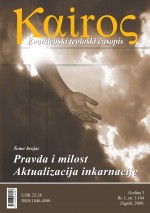Inkarnacija i umjetnost
Incarnation and art
Author(s): Krešimir ŠimićSubject(s): Christian Theology and Religion
Published by: Biblijski institut
Keywords: umjetnost; Martin Heidegger; inkarnacija
Summary/Abstract: Although art in its symbolic and aesthetic dimension has always been an important means for religious communication, it seems that in the secular world – when the traditional theological discourse becomes incommunicative – it becomes an autonomous theological scope, notably because it becomes a potential source of new theological cognition as well as a conclusive medium of communication, that is, a new discourse on faith. However, the philosophy of art which has been around for two millennia – notably from Martin Heidegger – began to observe art from an ontological perspective. Thus, art became not only a decoration of culture, but also the location for the manifestation of the Being, as indeed setting up the truth (M. Heidegger). Thereby the philosophy of art has approximated the theology of the core Christian incidence of the revelation: the incarnation of the Son of God, the Logos. Therefore it seems that the ontological deliberation of art as indeed setting up the truth viewed from a theological perspective allows, on the one hand, a clearer articulation of the theology of incarnation, and, on the other hand, the theology of incarnation offers valuable impulses for an ontologically based philosophy of art. In this paper, by analyzing the philosophy of art, precisely Heidegger’s ontology of the art, the author will endeavor to abstract the possible incentives for a theology of incarnation.
Journal: Kairos: Evanđeoski teološki časopis
- Issue Year: 3/2009
- Issue No: 1
- Page Range: 101-110
- Page Count: 9
- Language: Croatian

